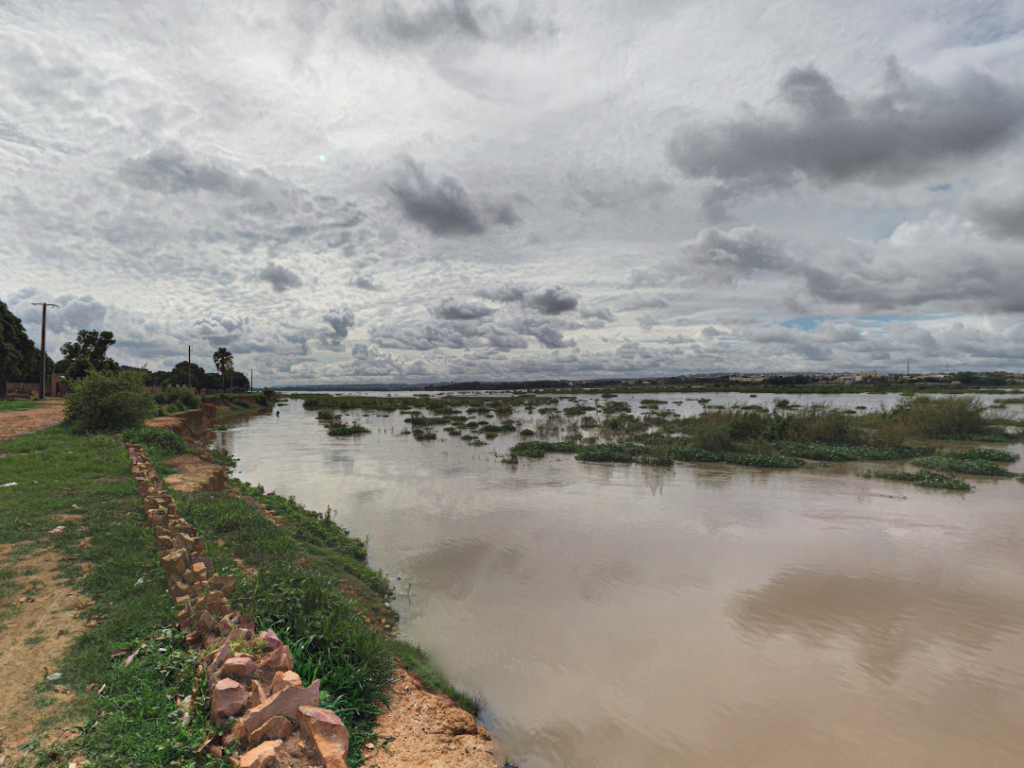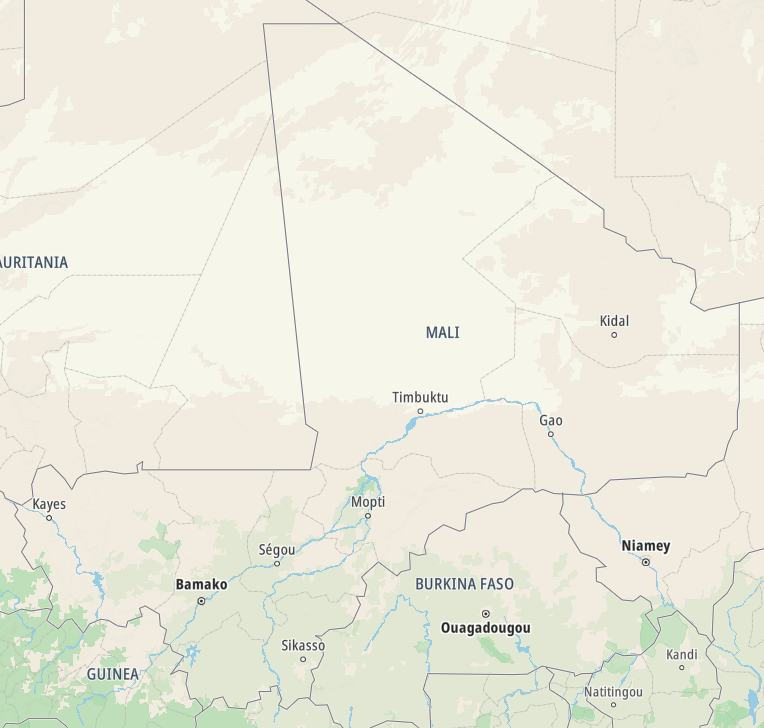Mali / République du Mali – Let’s explore here
What’s it like in Mali?
Mali is a landlocked, mainly flat, desert country in north western Africa, about five times the size of the UK. Historically it was the richest country in Africa and one of the richest in the world. Mansa Musa, reportedly one of the richest rulers in antiquity was from Mali. The highest point is Mount Hombori, near the border with Burkina Faso, at 3,789 ft (1,155 m) above sea level.
It has a long, rich and very troubled history, involving much political instability, resulting in it now being one of the least developed and poorest countries on the planet. It shares land borders with Algeria, Burkina Faso, Cote d’Ivoire, Guinea, Senegal, Mauritania and Niger.
The population of Mali is around 22 million people (2024), about one in five of whom live in the capital, Bamako It has a very young population, almost half the population are under the age of 15 years.

A bit about the history of Mali
Early History and the Mali Empire
Mali has a rich history that dates back to ancient times. The region was home to several significant civilisations, with the Mali Empire being one of the most powerful and influential in the medieval period. The Mali Empire, which reached its height during the 14th century, was founded by Sundiata Keita around 1235. Under his rule and that of his successors, including Mansa Musa, the empire expanded across much of West Africa. Mansa Musa, famous for his wealth and pilgrimage to Mecca, helped establish Mali as a centre of culture, education and trade, particularly in gold and salt.
Decline of the Mali Empire and Successor States
The Mali Empire began to decline in the late 14th century, weakened by internal strife, external invasions and the rise of neighbouring states. By the 16th century, the empire had fractured into several smaller states. The Songhai Empire, which emerged as a dominant power in the region, eventually eclipsed Mali’s influence, controlling vast territories along the Niger River. Following the decline of the Songhai Empire in the late 16th century, Mali became fragmented and largely under the control of regional kingdoms and empires, including the Bambara and the Tuareg.
French Colonial Rule
In the late 19th century, Mali, then part of French Sudan, became a French colony. The French colonised much of West Africa, and Mali was incorporated into French West Africa, with the French exploiting the region for its resources. During colonial rule, there was significant resistance from local populations, but Mali was largely subjected to French political and economic control. The French forced local populations into labour for the benefit of the colonial economy and implemented policies that changed the traditional way of life in the region.
Path to Independence
Mali, like many African nations, sought independence in the mid 20th century. In 1958, the French government offered its African colonies a choice between becoming autonomous or remaining under French control. Mali chose to become an autonomous republic within the French Community. In 1960, Mali declared full independence, with Modibo Keita becoming the first president. This marked the end of French colonial rule.
The Keita Era and Socialist Policies
Modibo Keita’s presidency was characterised by efforts to modernise and unify the country. He implemented socialist policies, nationalising key industries, and seeking to build a self sufficient economy. However, his government faced growing discontent due to economic difficulties, repression of political opposition and the failure of several major projects. These issues, along with rising dissatisfaction with his leadership, led to a military coup in 1968, which ousted Keita and ended Mali’s experiment with socialism.
Military Rule and the Transition to Democracy
After the coup in 1968, Mali was governed by a military regime led by Lieutenant Moussa Traoré. His government initially promised reform but soon became authoritarian. The military government faced significant challenges, including political repression, poor economic performance and rising discontent, especially in the face of a devastating drought in the 1970s. In the late 1980s, demands for political reform grew, and Mali underwent a series of protests and strikes. In 1991, these culminated in a popular uprising that forced Traoré from power. Mali then transitioned from military rule to a multi party democracy, and in 1992, the first democratic elections were held, with Alpha Oumar Konaré becoming president.
The Konaré Presidency
Alpha Oumar Konaré’s presidency marked the beginning of Mali’s democratic era. Under his leadership, Mali made significant strides in political and economic reform. The country became one of the most stable democracies in Africa, and Konaré worked to decentralise power and improve governance. Mali also became more integrated into the international community, particularly through participation in organisations like the United Nations and the African Union. Despite these positive developments, Mali faced challenges such as poverty, regional inequalities and a growing threat from extremist groups in the Sahel region.
The Touré Presidency and the 2012 Coup (2002–2012)
In 2002, Amadou Toumani Touré was elected president, marking a peaceful transition of power. Touré’s presidency was initially seen as a period of stability and reform, and Mali enjoyed considerable economic growth during the early years of his administration. However, the country began to face growing security challenges, particularly in the northern regions, where Tuareg separatists and Islamist militants began to gain influence. In 2012, a military coup took place in Mali, overthrowing Touré just months before the scheduled elections. The coup was led by junior military officers who cited Touré’s failure to manage the growing insurgency in the north as the reason for their actions. The coup destabilised the country and led to the occupation of northern Mali by Islamist groups, including al-Qaeda in the Islamic Maghreb.
The 2012 Crisis and International Intervention
The situation in northern Mali quickly deteriorated, with separatist groups and Islamist militants, including Ansar Dine, taking control of key cities, including Timbuktu. The occupation led to widespread human rights abuses, including the destruction of cultural heritage sites, forced conversions and the imposition of strict Sharia law. In response to the crisis, the United Nations and France intervened in 2013. Operation Serval, led by France, succeeded in pushing back the Islamist militants, and a peace agreement was signed in 2015 between the government and some Tuareg rebel groups. However, the security situation remained fragile, and extremist violence continued in the country.
The 2013 and 2018 Elections
Despite the ongoing security challenges, elections were held in 2013, with Ibrahim Boubacar Keita, who had served as prime minister in the 1990s, winning the presidency. His government focused on rebuilding the country and addressing security concerns, but his administration faced criticism for corruption, poor governance and its inability to fully resolve the conflict in the north. In 2018, Keita was re-elected in a contested election, but his second term was plagued by growing insecurity, protests, and discontent with his handling of the insurgency in the north and the economy. In August 2020, Keita was overthrown in a military coup led by Colonel Assimi Goita, citing widespread dissatisfaction with Keita’s government and the security situation.
The 2020–2021 Coup and Transition Period
Following the coup in 2020, a transitional government was established, and Goita assumed the presidency in May 2021 after a second coup. The transition government pledged to hold elections within a few years, but the political and security situation remains unstable. Mali’s military rulers have faced increasing pressure from both domestic groups and international organisations, including the Economic Community of West African States, to ensure the transition to civilian rule.
As of 2025, Mali remains in a fragile state, grappling with political instability, ongoing insurgencies in the north and economic difficulties. The transition back to civilian rule remains uncertain, and the country continues to face a complex security situation with armed extremist groups operating in the region. Mali’s future will depend on its ability to maintain political stability, achieve a peaceful resolution to conflicts, and improve governance and economic conditions for its population.

Mali road trip
Our Malian road trip is part of a much larger African road trip.
Our current planned road trip takes us close to Mali, and we may make a detour to visit the country, probably from either Senegal or Guinea. Although due to the current turbulence in the region, we may visit at another time. Whenever we do visit, hopefully our journey will improve our knowledge of this intriguing and beautiful country, and enable us to meet some interesting people. We’ll be updating this page at that time – don’t forget to check back 🙂
Map of Mali

What’s it like to drive in Mali?
They drive on the right hand side of the road in Mali. In the main roads are very poor, with many being unsurfaced dirt tracks. Driving standards are also poor.
Do you require an international driving permit in Mali?
We’ve created a dedicated page to driving abroad, which answers this question, and more, which you might find helpful.
Can you use your UK driving license when driving through Mali?
We’ve created a dedicated page to driving abroad, which answers this question, and more, which you might find helpful.
Do I need a carnet de passages to drive in Mali?
We’ve created a dedicated page to driving abroad, which answers this question, and more, which you might find helpful.
What currency do they use in Mali?
In Mali they use the West African CFA franc. Cash is widely used. The use of credit / debit cards is not widely accepted. Travellers cheques are not readily accepted. There are very few ATMs outside of the capital, Bamako.
The West African CFA franc is used in Benin, Burkina Faso, Guinea-Bissau, Côte d’Ivoire, Mali, Niger, Senegal and Togo.
You should make yourself aware of the amount that your bank charges you for using credit and debit cards abroad. Often credit cards are cheaper for purchasing items directly, and for withdrawing cash from ATMs.
What language do they speak in Mali?
They mainly speak Bambara in Mali, although there are 13 Malian languages officially recognised. French was also an official language until 2023, although it is not so widely spoken. English is not widely spoken.
What time zone is Mali in?
Remember, when you’re planning your next trip to take a look at what time zone it’s in.
Do I need a visa to visit Mali?
We’ve created a dedicated, more comprehensive page on visas, which you should find helpful. Check it out!
Is wild camping legal in Mali?
Yes, wild camping is fine in Mali.
What plug / socket type do they use in Mali?
In Mali they use plug / socket types C and E.


Health issues in Mali
Is it safe to drink water in Mali?
No, it is not safe to drink tap water in Mali. Bottled water is readily available throughout the country.
What vaccinations are required for Mali?
This NHS website is kept up to date with all relevant information on vaccinations in Mali.
Phones in Mali
What is the country calling code for Mali?
The country calling code for Mali is +223
What are the emergency phone numbers in Mali?
- The emergency number for police in Mali is: 17
- In Mali, the emergency number for ambulance is: 15 / 112
- The emergency number for fire in Mali is: 18 / 112
If you’ve got some useful info that you’d like to share, let us know!
And don’t forget to check out all the other pictures!
